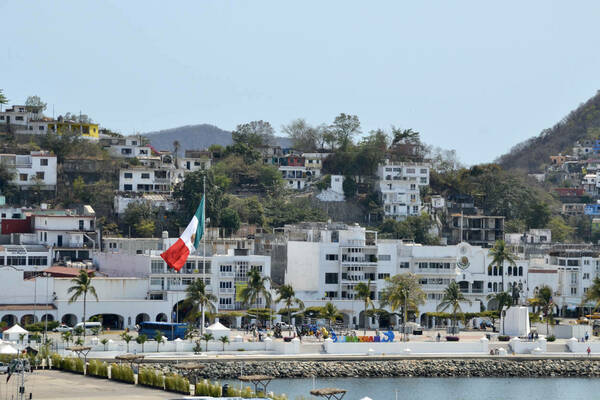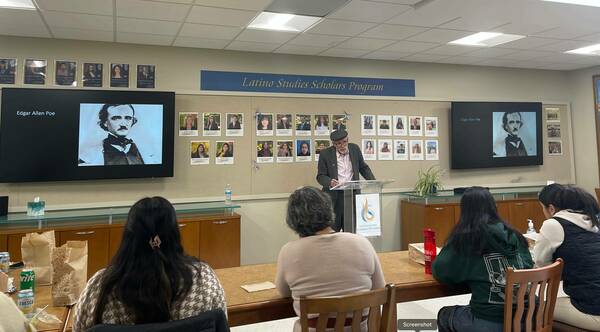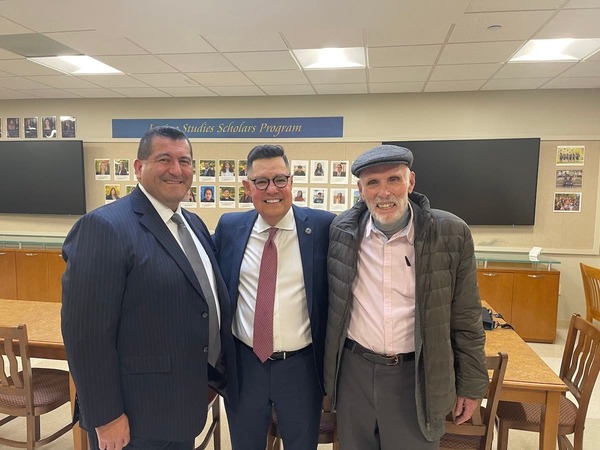
In late April, Notre Dame played fitting host for a special guest lecture on the role of Irish soldiers in the U.S.–Mexico war of 1846.
Dr. Michael Hogan, an Irish-American expat living in Guadalajara, spoke to a group of students, staff and faculty at the Institute for Latino Studies on April 24th about the Batallón de San Patricio, as the group of soldiers were known.
The involvement of these U.S. army defectors on the Mexican side, however, has been ignored in academic circles, a slight Hogan, as teacher, researcher and educational advisor, has worked tirelessly to redress.
“That’s the good ending — that it’s now in the school books,” Hogan told the audience of about 25 people in the ILS scholars lounge. Due in part to his work as a consultant to the College Board’s AP program, questions about the conflict now appear on their exams, he said.
After giving a brief lecture, Hogan shared the 1999 documentary Soldiers of St. Patrick. He said the History Channel at the time paid him $10,000 for the rights, only for Hogan to later realize that it was actually a “kill fee” — the production was too un-American to be shown in the U.S., he said.
His book, The Irish Soldiers of Mexico, has been published in fourteen editions in English and three in Spanish. It has served to inform an MGM feature film and two documentaries, according to Hogan. Another book by Hogan, Abraham Lincoln and Mexico, has been used in hundreds of schools and colleges in the U.S. and abroad.

The visit was sponsored by Martin Cabrera of Cabrera Capital Markets in Chicago, a banking and real estate development firm. The day afterward, Hogan was to visit Saint Ignatius College Prep in Chicago.
Sponsoring Hogan’s speaking tour was important in order to highlight the linkages between Mexicans and Irish, Cabrera said. For him, Latinos today are discriminated against like “the Irish of the 1840s.”
Indeed, one of the salient themes of the event was faith discrimination. The Irish were looked down upon because they were Catholic by the mostly Protestant Anglo-Saxon soldiery of the U.S. Army, Hogan said. Seeing churches desecrated and Catholicism disrespected in Monterrey and other parts of Mexico, John Reily and scores of Irish recruits joined the besieged Mexican army to form the Saint Patrick’s Battalion, also known as el batallón de los colorados, in reference to the red hair of some of the Irish soldiers.
Their efforts, though heroic, were not enough to prevent the great “land confiscation”, as Hogan put it. The war, coupled with the seizure of Texas by Stephen Austin and fellow Anglo settlers in the previous decade, eventually resulted in the loss of roughly half of Mexico’s territory. The new, roughly 2000-mile border between the US and Mexico was delineated by the Rio Grande, or Río Bravo, as it’s also known, and has remained so to this day.
Reily, who became a major in the Mexican army, is memorialized with a bust in the plaza de San Jacinto, in the San Angel neighborhood of Mexico City. An accompanying plaque memorializes his name alongside that of 70 members of the battalion, including a man with the surname Hogan; Dr. Hogan said this man by the name of Hogan was his ancestor.

Because Riley deserted before the US formally declared war against Mexico, he avoided the mass hanging suffered by about 50 of his fellow Saint Patrick’s Battalion members when they were court-martialed in occupied Mexico City in 1847. He was, however, branded on his cheek with the letter “D” to signify his desertion, Hogan said.
Much of the Irish emigration to North America was spurred by the Irish Potato Famine of the 1840s, Hogan said. Many Irish came through New York City, often living in deleterious conditions. Fighting in the army became a vital form of employment for many of them, while others may have been forcibly conscripted. Nearly a quarter of the population of Ireland – about 2 million people – died in what’s considered to be a famine orchestrated by the English, who shipped out the food supplies grown in Ireland.
One of the most prominent opponents of the Mexican-American war was Abraham Lincoln, Hogan said. Because of his anti-war position, he was ostracized politically for a number of years, never achieving prominent office until his eventual election as president in 1860.
One student in attendance was Paola Ortiz, a junior majoring in Political Science and Latino Studies. Before the event, she didn’t know much about the involvement of Irish soldiers on the Mexican side. Having heard the lecture and watched the documentary, she thought the idea of service to be a valuable lens in reading this historical chapter. Ortiz, who is also a LSSP scholar, is currently in Dr. Luis Fraga’s class, “Latinos in the Future of America.”
"There's a lot of history we don't know...it definitely motivates one to learn more and come to these types of lectures," she said. "This is about how service transcends race and ethnicity."
Dr. Hogan’s work has appeared in journals such as the Paris Review, the Harvard Review, Political Affairs, History Ireland, and the Monthly Review. He is the Latin American consultant to State Department’s Office of Overseas Schools. At the moment, he is Emeritus Chair of the Humanities Department at the American School Foundation of Guadalajara. There, he founded the Advanced Placement Program and has taught for more than two decades. He has lived in Colonia Providencia in Guadalajara for the past thirty years with the textile artist Lucinda Mayo.